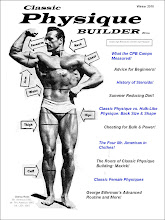 Classic physique building in the western world has its roots in the culture of the ancient Greeks. Classical and Hellenistic sculpture give ample evidence of the Greek ideal of a muscular, well-defined body of symmetrical proportions. This can be seen in the well-known sculptures of the Discus Thrower by Myron of Eleutherae (5th Century B.C.E.), the Spearbearer by Polykleitos of Argos (5th Century B.C.E.), the Scraper and Farnese Hercules by Lysippos of Sicyon (4th Century B.C.E.).
Classic physique building in the western world has its roots in the culture of the ancient Greeks. Classical and Hellenistic sculpture give ample evidence of the Greek ideal of a muscular, well-defined body of symmetrical proportions. This can be seen in the well-known sculptures of the Discus Thrower by Myron of Eleutherae (5th Century B.C.E.), the Spearbearer by Polykleitos of Argos (5th Century B.C.E.), the Scraper and Farnese Hercules by Lysippos of Sicyon (4th Century B.C.E.).Not only was athleticism a strong cultural value among the ancient Greeks, but physical aesthetics – how the body looked – was clearly an accompanying interest. Polykleitos published a book called Canon which outlined the ideal mathematical proportions or symmetry for the various parts of the human body. This idea that the beauty of the body was dependent upon the harmonious proportions or symmetry of its parts was embodied by his sculpture the “Spear Bearer.”
Although, at this point in history, there is no evidence of bodybuilding for the sake of physical aesthetics alone, it is from the ancient Greeks that we derive our ideal of an aesthetically pleasing muscular, well-defined, and symmetrical body. (photo: above left - The "Farnese Hercules by Lysippos)







No comments:
Post a Comment